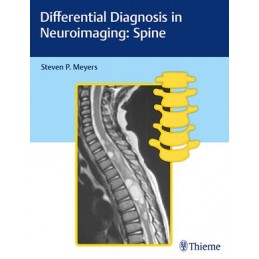- Reduced price

Order to parcel locker

easy pay


 Delivery policy
Delivery policy
Choose Paczkomat Inpost, Orlen Paczka, DHL, DPD or Poczta Polska. Click for more details
 Security policy
Security policy
Pay with a quick bank transfer, payment card or cash on delivery. Click for more details
 Return policy
Return policy
If you are a consumer, you can return the goods within 14 days. Click for more details
A unique, easy-to-use, and definitive guide to diagnostic spine imaging
Authored by renowned neuro-radiologist Steven P. Meyers, Differential Diagnosis in Neuroimaging:: Spine is a stellar guide for identifying and diagnosing cervical, thoracic, lumbar, and sacral spine anomalies based on location and neuroimaging results. The succinct text reflects more than 25 years of hands-on experience gleaned from advanced training and educating residents and fellows in radiology, neurosurgery, and orthopaedic surgery. The high-quality MRI, CT, and X-ray images have been collected over Dr. Meyerss lengthy career, presenting an unsurpassed visual learning tool.
The distinctive three-column table plus images format is easy to incorporate into clinical practice, setting this book apart from larger, disease-oriented radiologic tomes. This layout enables readers to quickly recognize and compare abnormalities based on high-resolution images.
Key Highlights
This visually rich resource is a must-have diagnostic tool for trainee and practicing radiologists, neurosurgeons, neurologists, physiatrists, and orthopaedic surgeons who specialize in treating spine-related conditions. The highly practical format makes it ideal for daily rounds, as well as a robust study guide for physicians preparing for board exams.
Data sheet
Introduction
Table 1.1 Congenital and developmental abnormalities of the spinal cord or vertebrae
Table 1.2 Abnormalities involving the craniovertebral junction
Table 1.3 Intradural intramedullary lesions (spinal cord lesions)
Table 1.4 Dural and intradural extramedullary lesions
Table 1.5 Extradural lesions
Table 1.6 Solitary osseous lesions involving the spine
Table 1.7 Multifocal lesions and/or poorly defined signal abnormalities involving the spine
Table 1.8 Traumatic lesions involving the spine
Table 1.9 Lesions involving the sacrum
Reference: 32793
Author: Neil P. Sheth
Reference: 43896
Author: Nestor L. Muller
Expert Consult - Online and Print
Reference: 102784
Author: Neal H. Cohen
Reference: 71900
Author: Bert Hayslip
Reference: 52339
Author: Steven P. Meyers
Differential Diagnosis and Atlas
Reference: 6210
Author: Uschi Ostermeier-Sitkowski
